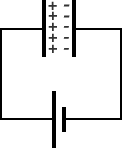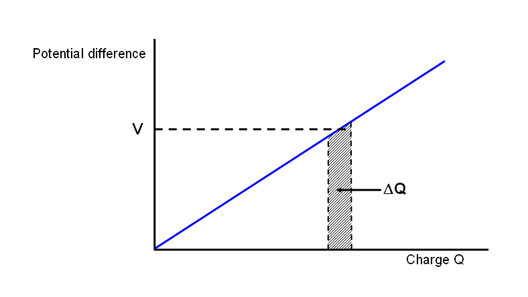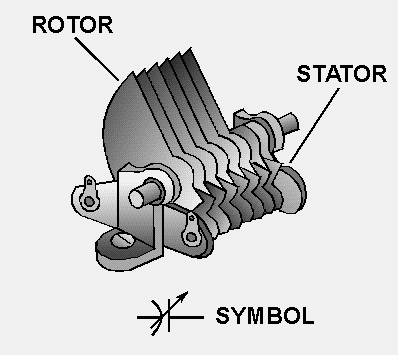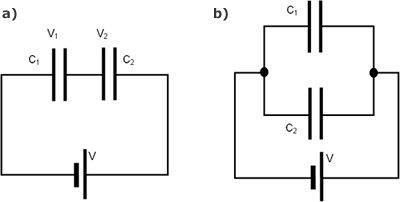Capacitors
Various types of capacitor

Figure 1. The symbol for an unpolarised capacitor.
Normally, electrons cannot enter a conductor unless there is a path
for an equal amount of electrons to exit. However, extra electrons can
be "squeezed" into a conductor without a path to exit if an electric field
is allowed to develop in space relative to another conductor. The
number of extra free electrons added to the conductor (or free electrons
taken away) is directly proportional to the amount of field flux
between the two conductors.
In this simplified capacitor the dielectric is air. When a voltage, V is applied to the terminals of the capacitor, electrons flow on to one of the plates and are taken off the other plate. The total number of electrons in the capacitor remains the same. There are just more on one the negative plate and fewer on the positive plate.

Figure 2. Charging a capacitor with a battery
If the volage were increased the increased potential difference
between the plates would push more electrons on to the negatively
charged plate. We could measure the charge stored on the plate as a
function of different applied voltages.
At zero voltage, the capacitor plates are neutral and so no charge is stored. (we assume that we started with a fully discharged capacitor), at a voltage V the charge on the plates is Q and at twice the voltage, the charge is doubled. We find that for increasing voltage the charge increases linearly. We can plot this as a straight line.
Suppose that we go away and do some research and come back with a better capacitor which stores more charge for a given voltage we can plot the result of the charge stored as a function of applied voltage
This would be represented as another line with a steeper slope. If we plotted lots of graphs for different capacitors we would get many straight lines. We can say that a measure of the capacitance is the how much the charge is stored for a given voltage. This is sometimes expressed as Q=CV.
Of course in charging the capacitor work must be done to move the charge. Therefore energy must be supplied and this energy is available when the capacitor is discharged.
 The work done is given by W=qV. Initially the charge is
easily moved onto the plates of the capacitor, however as more charge
is moved onto the capacitor plates the repulsive force between the
charges makes it harder to add charge, when the repulsive force of the
charges equals the power of the battery, no more charge can be moved
onto the plates. Therefore the average work is 1/2qV. If we look
at our graph of charge against voltage we can recognise this is the same
as the area under the curve. In general, the work done is equal to the
energy transferred. Mathematically,
The work done is given by W=qV. Initially the charge is
easily moved onto the plates of the capacitor, however as more charge
is moved onto the capacitor plates the repulsive force between the
charges makes it harder to add charge, when the repulsive force of the
charges equals the power of the battery, no more charge can be moved
onto the plates. Therefore the average work is 1/2qV. If we look
at our graph of charge against voltage we can recognise this is the same
as the area under the curve. In general, the work done is equal to the
energy transferred. Mathematically,


Factors Affecting Capacitance
How can we increase the capacitance of a parallel plate capacitor? There are three factors which affect the capacitance of a parallel plate capacitor.Area

A variable capacitor
Separation
Decreasing the separation of the plates, decreases the voltage of the capacitor since the electric-field is not affected by the distance between the plates. The voltage on the capacitor is V=Ed. Therefore the voltage increases. For a constant charge, Q, C=Q/V =Q/Ed.Dielectric Constant
The capacitance of a parallel plate capacitor is given by C=εr A/d, where A is the area of the plates, d is the separation between the plates and εr is the relative permiliability of the dielectric between the plates. The relative permiability is some factor, K multiplying the permiability of free-space ε0. ε0 has a value of 8.85x10-12 F.m-1.A full list of relative permiabilities can be found for almost any dielectric material. The greater the relative permiability the greater the capacitance of the capacitor. Some good materials are Mica, polystyrene, oil.
εr=K ε0
Capacitor Networks

Figure 3. Capacitor networks in Series and Parallel
Series
Consider the series network of capacitors shown in Figure 3a. where the positve plate is conected to the negative plate of the next.What is the equivalent capacitance of the network? Look at the plates in the middle, these plates are physically disconected from the circuit so the total charge on them must remain constant. It follows that when a voltage is applied across both of the capacitors, the charge +Q on the positive plate of capacitor C1 must be balanced by the charge -Q on the negative plate of capacitor C2. The net result is that both capacitors possess the same charge Q. The potential drops V1 and V2 across the two capacitors are in general, different. However, the sum of these drops equals the total potential drop V applied across the input and output wires. V=V1 + V2. The equivalent capacitance of the pair is again CT=Q/V. Thus, 1/CT = V/Q = (V1 + V2)/Q = V1/Q + V2/Q giving

Parallel
For a parallel circuit such as in Figure 3b. the voltages are the same across each component. However the total charge is divided between the two capacitors since it must distribute itself such that the voltage across the two is the same. Also, since the capacitors may have different capacitances C1 and C2 the charges Q1 and Q2 must also be different. The equivalent capacitance CT of the pair of capacitors is simply the ratio Q/V where Q=Q1+Q2 is the total stored charge. It follows that CT = Q/V = (Q1+Q2)/V = Q1/V + Q2/V giving

Charging and Discharging Capacitors
A circuit consisting of a battery, a switch, a resistor and a capacitor in a series loop is called an "RC" circuit. Kirchoff's voltage law for this circuit isV = IR + Q /C. When expressed purely in terms of the charge, this becomes
V = dQ/dt R + Q/C.
This is a differential equation, whose solution is an exponential function. When the switch is closed, the capacitor charges over time:
Q = Qf (1 - e-t/RC),
where Q is the charge at time t and Qf is the final charge on the capacitor. Note that Q never equals Qf , but as t gets extremely large, Q gets arbitrarily close to Qf. The product RC is called the RC time constant, and is a characteristic quantity of the RC circuit. When t = RC, the capacitor has charged to a fraction (1 - 1 / e, about 63%) of its final value. It is necessary to use a time constant, and not some sort of terminal time, since the process is asymptotic. Its value is an arbitrary choice; we naturally choose a value in terms of the exponential base (when the exponent is negative one).
No comments:
Post a Comment